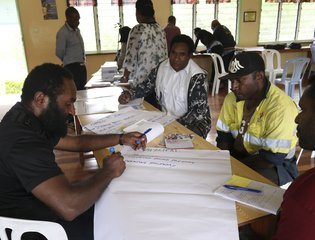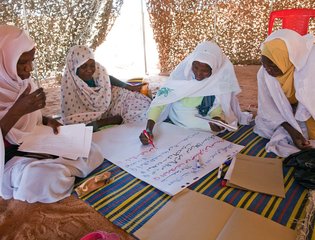Marking ALNAP's 25th Anniversary year in 2022, the Spotlight on Learning series comprises four distinct papers examining different aspects of learning in humanitarian contexts. The series aims to explore how and when the sector learns, and – crucially – when it doesn’t.
The first paper, 'Communicating Humanitarian Learning: What do we know?’ investigates current evidence on how the sector communicates learning to inform policy and practice. In this blog, author of the paper Jo-Hannah Lavey highlights five key insights from the existing literature.
As humanitarians, learning is core to everything we do. Every crisis is different. Every population living through the crisis has different capacities and different needs. We must quickly learn to understand what these differences are, and how to best adapt humanitarian responses to each context.
The concept of communicating humanitarian learning was a surprisingly difficult one to unpack. What exactly do we mean by ‘learning’? And how do we use communications to guide people through such a complex process? I was surprised by the range of subjects involved and the depth of the literature in each, as well as by the lack of literature linking it all together. At the same time, I was fascinated by what we do know, and I found it useful to be explicit about the evidence we have.
These following insights from the literature may seem common sense to many humanitarians, but they have important implications for any individual or organisation that produces humanitarian learning. There is still much for us to learn about how communication in the sector can improve policy and practice, and I hope this paper provides a useful springboard for further research.
Insight 1: Change is complex. It takes time and often does not succeed.
Improving policy and practice requires behaviour change. This is difficult to achieve in any sector, but characteristics often present in humanitarian organisations can make change even more complex. These include: high staff turnover, short programme cycles, time pressures, geographically dispersed structures, and increasing diversity of central actors (Knox-Clarke, 2017).
Change takes time, with estimates from the health sector saying it may take up to 17 years for evidence to reach clinical practice (Morris, Wooding and Grant, 2011).
Change is also an emotional as well as practice process. The COM-B model, used by the UK Government when developing communication strategies, holds that an individual must have the capability and motivation to undertake a behaviour, while external factors must provide the opportunity. Effective communication can help shift people’s capability through knowledge and understanding, and their motivation through beliefs and attitudes.
Insight 2: Documented evidence is a small contributor to change.
Change will not happen through documented evidence alone. In fact, only a minority of humanitarian evaluations effectively inform change (Sandison, 2006). This may be due to a lack of generalisable or relevant evidence, a preference for tacit learning (see Insight 3), time pressures or funding constraints (Carden, Hanley and Paterson, 2021).
Guidance from Elrha tells us that for research to be applied, humanitarians require clear, practical strategies beyond sharing research findings, such as capacity building and opportunities for stakeholder engagement.
Insight 3: Humanitarians prefer tacit, networked knowledge over documentation.
Humanitarian workers are highly selective in the uptake of evidence. They prefer to access knowledge through networks and conversations, and to base their decision-making on knowledge gained through their own — or their colleagues’ — lived experience, rather than knowledge available in documented form (Beck, Borton and Houghton, 2003; Darcy et.al., 2013).
Accessing tacit learning processes is a particular challenge for researchers and those working to change policy or practice — it requires engagement and insight into how intended users like to learn, and is far more time intensive than distributing documented research.
Insight 4: Humanitarians access knowledge that is immediately relevant.
The ‘relevance’ of learning is a repeated theme throughout the literature. Evidence is more likely to be used when it responds to a direct need (Knox-Clarke, 2017), when it is timely, and when there are opportunities for meaningful participation and follow up (Sandison, 2006). This is a critical consideration for producers of humanitarian research and evidence, who too often produce research not relevant to intended users—and even less relevant to the needs of humanitarians from the Global South (Carden, Hanley and Paterson, 2021).
Insight 5: National actors are not sufficiently included.
As noted above, evidence and learning is not reaching national actors to the extent that it should. Compared to international actors, national humanitarian practitioners have less access to opportunities to share tacit learning (Beck, Borton and Houghton, 2003) and the research produced in the sector is less relevant to them (Carden, Hanley and Paterson, 2021). At the same time, international actors do not adequately access learning from national actors or the affected population (Beck, Borton and Houghton, 2003). This must be addressed in order for the sector to improve and better support those affected by crisis.
Crucially, we found that there are prominent gaps in the existing evidence-base for communicating humanitarian learning. We don’t have sufficient evidence to know which approaches to communicating learning are most effective at influencing humanitarian policy or practice. How do humanitarians in different roles or in different parts of the world prefer to access information that helps them learn? Which formats do they prefer? Which channels? The answers to these questions could help individuals and organisations better engage with each other, with their audiences, and with the policies and practices they are working to improve. So, how do we find them?
"[As a sector] we don’t have sufficient evidence to know which approaches to communicating learning are most effective at influencing humanitarian policy or practice."
ALNAP is taking forward Communicating Humanitarian Learning as a research agenda, working with partners to analyse preferences of humanitarians when consuming and sharing knowledge and evidence.
The aim is to gather as many different perspectives from across the global humanitarian sector as possible to form a strong evidence base for future guidance on reaching humanitarians with the information they need to improve humanitarian action.
As humanitarians, your views are vital in enabling ALNAP and the wider sector share knowledge and evidence that works for you. Please get in touch with us and share your feedback on how at ALNAP we can improve the way that we communicate learning so it better helps you.


